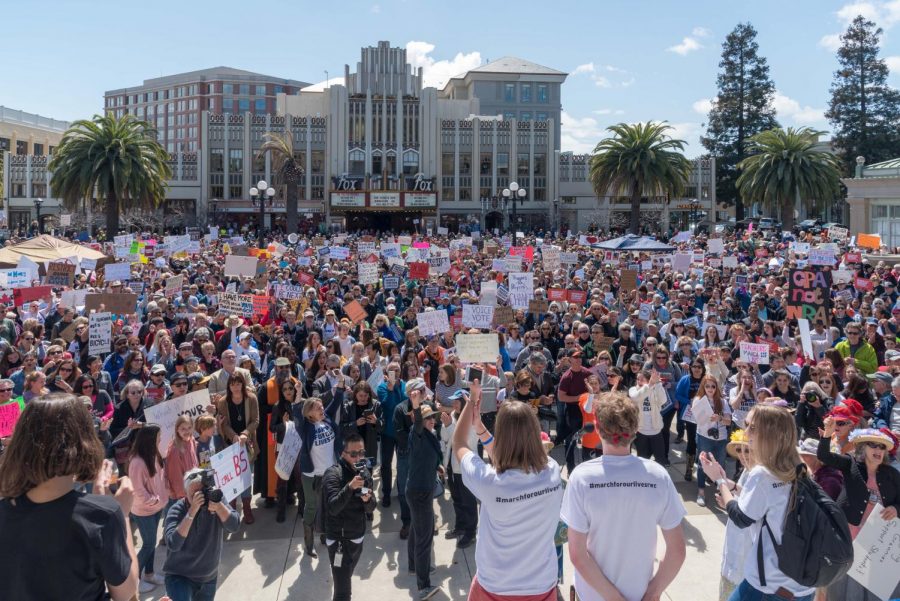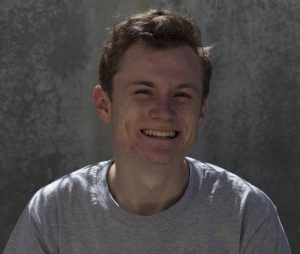REDWOOD CITY, CA- Thousands of students and adults flooded into the Redwood City courthouse square Saturday to take part in the nationwide March For Our Lives event.
Hundreds of marches and rallies took place across the nation on March 24th in protest against school shootings and gun violence. What made these protests unique, however, was the fact that they were organized largely by young people. I am one of these young people.
Before I continue, I would like to make clear that I am in no way attempting to extrapolate my experiences with the Redwood City March for our Lives rally to the entire nationwide movement. I understand that each event will have its own strengths and weakness.
Ria Calcagno, a Woodside senior serving as the student trustee for the Sequoia Union High School District, first put me in touch with other student working to organize a March for Our Lives event nearer to the district’s students. This group included Sophie Penn of Carlmont, Katie Uthman of Sequoia, and Elise Kratzer and Holly Newman of Menlo-Atherton. Right from the beginning, their maturity and dedication assured me that I was working with people who understood their goals, and, more importantly how they were going to achieve them.
While we knew of larger events planned in San Francisco and San Jose, we recognized that many people, especially students, could not easily commute to these protests. If we hoped to rope in as many young people as possible, we had to make protesting accessible to everyone.
I knew the fear that gripped students after the Parkland shooting first-hand; I had seen the nervous looks of students shuffling out of class during a fire drill and read the texts of those who worried about a shooting on their campus. This is an issue that impacts all of us, so it stands to reason that all of us should have the opportunity to speak out and offer input on a solution to school shootings and gun violence.
This reasoning helped us focus on what exactly we hoped to achieve. The rally wasn’t meant to attack the National Rifle Association or criticize conservative politicians; we were only trying to create an environment where young people could express their beliefs and work together towards an end to the dangers they face today. Hopefully, this opportunity encourages students to remain politically involved in issues ranging beyond gun violence as well, molding them into life-long activists and leaders.
Working towards this goal, our organizational process was truly a testament to the power of the internet and social networks, as most communication and outreach took place through these media. I, for example, was in charge of voter registration at the rally and communicated with local political groups exclusively through email leading up to the event. It was through the internet that we also received a $5,000 grant from the March for Our Lives national organization and purchased materials to be handed out during the rally.
Looking back now, I could not be more proud of what we achieved as a group. I watched in awe as hundreds of people began gathering in front of the old Redwood City museum an hour before the rally was set to begin. I saw the determination in the eyes of the other organizers as they hustled around the square, coordinating with all of the voter registration and gun violence groups that had set up tables and posters.
What impressed me the most, though, was the eloquence and passion with which student speakers delivered their speeches and poems. These voices were the reason why we had worked so hard. And even though their opinions would help shape policy, I never appreciated how they could impact adults until I saw the reactions of those standing in the crowd. Their speeches weren’t just convincing politicians to take gun violence seriously; they were convincing like-minded adults that they were capable of thinking critically and speaking articulately.
The Redwood City Police Department estimated that between 3,500 and 4,000 attended the rally and, speaking from the courthouse steps, I can say that I heard every one of their voices. I’ll never feel as proud to be American as I did watching the sea of signs and posters jutting out from an even greater sea of faces.
However, the protest did reveal flaws in our planning— some larger than others. Minor issues like a lack of internet access for voter registration or a small delay due to power issues are worrisome, but did not detract from the overall purpose of the rally.
Before student speakers came up to give their speeches, I asked all students and young people in the audience to come to the front of the crowd to hear and support their peers. I was stunned by how few high schoolers and middle schoolers stepped forward. Despite the fact that the rally had been geared towards young people and heavily advertised over social media, I was struck by the proportion of the crowd made up of adults. Perhaps a stronger social media campaign and a more concerted effort through other platforms may have brought more students to the event.
After the rally, a young man approached me with his group of friends and asked to speak with me, identifying himself only as Alex. He questioned why so many of the speakers had been white when gun violence was so prevalent in communities of color as well.
A little defensive and riding a post-event high, I asked why he had not come up to speak if he felt like his side of the story was not being told. Alex then went on to describe the nervous, suspicious looks he had received from adults and other young people in the crowd when he tried to come to the front to do just that.
His story highlights another major flaw in how the event had been organized. If we truly had wanted to bring in as many students as possible, we needed to work with student leaders from all groups and a greater variety of high schools. Even though our organizing committee was smart and dedicated, it was in no way diverse. Working with leaders from a greater range of ethnic, socioeconomic, and geographic backgrounds may well have helped with this issue.
In conclusion, while I am proud to have worked with other students to put together such a popular event, I have to acknowledge where we could have done better.
For all who hope to bring people together for the same reasons we did: remember which group you hope to get involved, then focus of getting all of them there.
I hope that this reflection has not turned young people away from becoming active and organizing something similar. Instead, I wish that, when they consider the power that we as students hold, they take the responsibilities into account as well.






